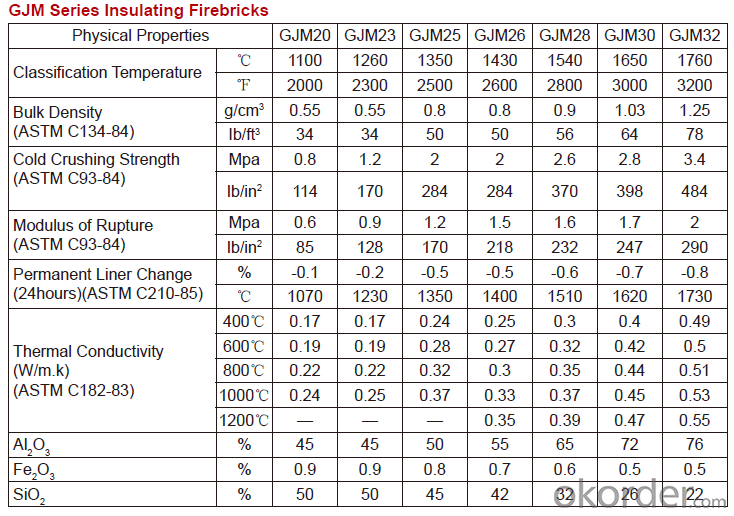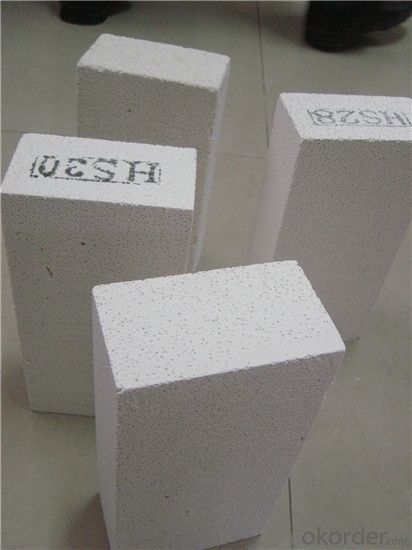GJM 25 Fire Light Mullite Insulation Brick Product
- Loading Port:
- Shanghai
- Payment Terms:
- TT OR LC
- Min Order Qty:
- 1 m.t.
- Supply Capability:
- 10000 m.t./month
OKorder Service Pledge
OKorder Financial Service
You Might Also Like
Thermal Insulation Fire Clay Brick
Refractory brick is a refractory material used in lining furnaces, kilns, fireboxes, and fireplaces.
We provide high quality Refractory Fire Bricks that are used on wide range in the various industries like Cement, Glass and Steel. Refractory Fire Bricks are provided as per the quantity and specifications required by the customers. We provide an extensive range of Refractory Fire Bricks at reasonable prices that depend upon the quantity ordered.
Application
Insulating Fire Brick are used for the lining of converter, alternating current arc furnace, direct Current arc furnace and the ladle slag line, etc.
Company Advantage
(1)Long Insulating Fire Brick manufacture history: 25 years manufacturer
(2)Advanced equipment and good service
(3)Diversification of production standards: ISO ANSI FEPA JIS ASTM
(4)Flexible payment: T/T L/C D/P D/A
(5)Professional marketing team and after-sale service
Insulating Fire Brick main feature:

Equipment
1 unit of Ceramic Abrasive (SG Abrasive) pilot production line
2 units of Compact grain Abrasive pilot production lines
1 unit of high-end coated abrasives (abrasive cloth) production line
3 large flexible crushing and sieving lines for grit production lines
6 units of 5000KVA-10000KVA dumping type electric arc furnaces for Brown Fused Alumina fusion
FAQs
Q1 What’s the transport method?
A1 FCL delivery goods with wooden pallet or wooden case by sea; If LCL delivery, must with wooden case; Sometimes need open top, flat rack or bulk cargo.
Q2 What’s the required payment term?
A2 Generally 30% TT as the prepayment, 70% TT before delivery. If need, 100% Irrevocable Letter of Credit or negotiation.
Q3 Which country are our products exported to?
A3 Apart from entire Chinese market, the US, Russia, Japan, Korea, Australia and some Southeast Asian Nations.


- Q:Is sintering insulation brick good or concrete porous brick good?
- As with the expansion screw, it depends on what to connect, and go in is no problem, the key is that the carrying capacity is not very high, if you do steel support, pull and so on, it is recommended to use concrete.
- Q:Can insulating fire bricks be used in fireplace construction?
- Yes, insulating fire bricks can be used in fireplace construction. They are designed to withstand high temperatures and provide excellent insulation, making them a suitable choice for building fireplaces.
- Q:Can insulating fire bricks be used in the construction of thermal insulation roofs?
- Yes, insulating fire bricks can be used in the construction of thermal insulation roofs. Insulating fire bricks are specially designed to have high thermal insulation properties, making them an ideal choice for applications that require heat retention and energy efficiency. These bricks are made from lightweight materials such as clay, which have low thermal conductivity and high resistance to heat transfer. This allows them to effectively reduce heat loss or gain, making them suitable for use in thermal insulation roofs. Additionally, insulating fire bricks are durable and can withstand high temperatures, making them a reliable choice for long-term use in roofing applications.
- Q:Are insulating fire bricks suitable for use in wood-fired ovens?
- Indeed, insulating fire bricks are appropriate for utilization in wood-fired ovens. These bricks have been meticulously crafted to endure extreme temperatures, rendering them exceptionally suitable for deployment in ovens or other heat-intensive scenarios. Insulating fire bricks boast exceptional thermal insulation properties, aiding in the preservation of heat within the oven and guaranteeing a more effective cooking procedure. Moreover, these bricks exhibit low thermal conductivity, signifying that they transmit less heat to the external surfaces, resulting in a cooking experience that is both safer and more comfortable. Consequently, the utilization of insulating fire bricks in wood-fired ovens can yield superior heat retention, enhanced energy efficiency, and an overall improved performance.
- Q:Can insulating fire bricks be used for insulation in steel mills?
- Yes, insulating fire bricks can be used for insulation in steel mills. Insulating fire bricks are specifically designed to withstand high temperatures and are used in various industrial applications, including steel mills, to provide thermal insulation and reduce heat loss. They help maintain consistent temperatures, improve energy efficiency, and protect equipment and structures from extreme heat.
- Q:Can insulating fire bricks be used in residential applications?
- Yes, insulating fire bricks can be used in residential applications. Insulating fire bricks are lightweight and have excellent thermal insulation properties, making them suitable for various residential uses. They can be used to insulate fireplaces, wood-burning stoves, and chimneys, helping to increase energy efficiency and reduce heat loss. Additionally, insulating fire bricks can be utilized in the construction of pizza ovens and outdoor grills, providing excellent heat retention and insulation. Their ability to withstand high temperatures makes them ideal for these applications. Overall, insulating fire bricks offer homeowners a reliable and durable solution for enhancing the insulation and heat retention in residential settings.
- Q:Can insulating fire bricks be used in smelting furnaces?
- Yes, insulating fire bricks can be used in smelting furnaces. Insulating fire bricks are designed to have low thermal conductivity, which helps to conserve heat and maintain high temperatures inside the furnace. This makes them an ideal choice for smelting furnaces where high temperatures are required. Additionally, insulating fire bricks also have a high resistance to thermal shock, which means they can withstand rapid temperature changes without cracking or breaking. This is particularly important in smelting furnaces where the temperature can fluctuate significantly. Overall, insulating fire bricks are an excellent option for smelting furnaces as they help to improve energy efficiency, reduce heat loss, and provide durability in high-temperature environments.
- Q:Are insulating fire bricks resistant to cracking?
- Yes, insulating fire bricks are designed to be highly resistant to cracking. They are manufactured to withstand high temperatures and thermal shocks, ensuring their durability and preventing cracks from developing.
- Q:Can insulating fire bricks be used in the construction of industrial chimneys?
- Indeed, insulating fire bricks are capable of being utilized in the construction of industrial chimneys. These bricks are meticulously crafted with exceptional thermal insulation properties, rendering them perfectly suited for situations where precise temperature management is paramount. Given that industrial chimneys endure elevated temperatures and heat transmission, insulating fire bricks prove invaluable in mitigating heat dissipation or acquisition, thereby enhancing energy efficiency and minimizing the likelihood of structural harm. Furthermore, these bricks exhibit commendable resilience against thermal shock, enabling them to endure the rigorous conditions commonly encountered in industrial environments. Consequently, insulating fire bricks emerge as a fitting choice for constructing industrial chimneys.
- Q:Do insulating fire bricks require any special curing or firing temperature profiles?
- Yes, insulating fire bricks do require special curing or firing temperature profiles. These bricks are typically made from lightweight refractory materials, which need to be slowly heated and cooled to avoid cracking or damage. The curing process involves gradually increasing the temperature over several hours and holding it at a specific level for a certain period. This allows the bricks to undergo physical and chemical changes, ensuring their optimal performance and durability in high-temperature applications.
1. Manufacturer Overview |
|
|---|---|
| Location | |
| Year Established | |
| Annual Output Value | |
| Main Markets | |
| Company Certifications | |
2. Manufacturer Certificates |
|
|---|---|
| a) Certification Name | |
| Range | |
| Reference | |
| Validity Period | |
3. Manufacturer Capability |
|
|---|---|
| a)Trade Capacity | |
| Nearest Port | |
| Export Percentage | |
| No.of Employees in Trade Department | |
| Language Spoken: | |
| b)Factory Information | |
| Factory Size: | |
| No. of Production Lines | |
| Contract Manufacturing | |
| Product Price Range | |
Send your message to us
GJM 25 Fire Light Mullite Insulation Brick Product
- Loading Port:
- Shanghai
- Payment Terms:
- TT OR LC
- Min Order Qty:
- 1 m.t.
- Supply Capability:
- 10000 m.t./month
OKorder Service Pledge
OKorder Financial Service
Similar products
New products
Hot products
Related keywords


























